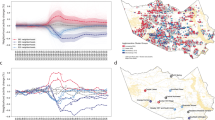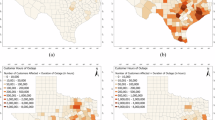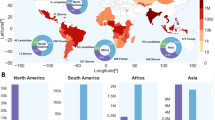Abstract
During and after a disaster, people share resources with family, friends and neighbors to tide them over difficult times. The conventional top-down approach for disaster relief overlooks the wealth of critical resources that exist within communities. Here we explicitly model place-based peer-to-peer (P2P) resource sharing and evaluate its impact on community resilience to disasters. Using data from two urban communities in Seattle, Washington State, we confirm substantial untapped capacity for enhanced community resilience through place-based P2P resource sharing. Under a 5-day isolation scenario, place-based P2P sharing can reduce a community’s resilience loss by 13.4–100%; on average, 22–44 social ties per household support an 80% sharing rate of surplus resources. These findings suggest that place-based P2P sharing could be a viable strategy for disaster response across US communities, in addition to the current, government-led effort. Our methodological framework is transferable to other urban communities interested in enhancing disaster resilience.
This is a preview of subscription content, access via your institution
Access options
Subscribe to this journal
Receive 12 digital issues and online access to articles
118,99 € per year
only 9,92 € per issue
Buy this article
- Purchase on SpringerLink
- Instant access to full article PDF
Prices may be subject to local taxes which are calculated during checkout





Similar content being viewed by others
Data availability
The survey data collected in the study contain household mailing addresses and names, and this part of the data is not available due to privacy issues. However, the generated aggregated data during the current study are available via GitHub at https://github.com/UW-THINKlab/P2P_sharing_open_source.
Code availability
The code used for the analysis is available via GitHub at https://github.com/UW-THINKlab/P2P_sharing_open_source.
References
Twigg, J. & Mosel, I. Emergent groups and spontaneous volunteers in urban disaster response. Environ. Urban. 29, 443–458 (2017).
Prociv, K. Pic of the week: people helping people after Hurricane Matthew. The Washington Post https://www.washingtonpost.com/news/capital-weather-gang/wp/2016/10/28/pic-of-the-week-people-helping-people-after-hurricane-matthew/ (2016).
Martinez, M. Texans used mutual aid to help their communities through a devastating winter storm. The Texas Tribune https://www.texastribune.org/2021/02/23/mutual-aid-texas-storm/#:~:text=What%20started%20as%20an%20oatmeal,help%20them%20escape%20the%20cold (2021).
Greenfield, N. Mutual aid and disaster justice: ‘we keep us safe’. NRDC https://www.nrdc.org/stories/mutual-aid-and-disaster-justice-we-keep-us-safe (2022).
National Incident Management System (Federal Emergency Management Agency, US Department of Homeland Security, 2017).
Whole Community Approach to Emergency Management: Principles, Themes, and Pathways for Action (Federal Emergency Management Agency, US Department of Homeland Security, 2011).
Kim, K., Ghimire, J. & Yamashita, E. Sharing during Disasters: Learning from Islands Preliminary Findings and Initial Implications for Action (Natural Hazards Center Research Resources, 2021).
Wong, S. D., Yu, M., Kuncheria, A., Shaheen, S. A. & Walker, J. L. Willingness of Hurricane Irma evacuees to share resources: a multi-modeling approach. Transportmetrica A 19, 2017064 (2023).
Idziorek, K., Abramson, D. B., Kitagawa, N., Yamamoto, T. & Chen, C. Factors influencing willingness to share resources postdisaster: a cross-cultural comparison between US and Japanese communities. Nat. Hazards Rev. 24, 04023044 (2023).
Zimmerman, R. Social implications of infrastructure network interactions. J. Urban Technol. 8, 97–119 (2001).
Chang, S. E. & Shinozuka, M. Measuring improvements in the disaster resilience of communities. Earthq. Spectra 20, 739–755 (2004).
Davis, C. A. Water system service categories, post-earthquake interaction, and restoration strategies. Earthq. Spectra 30, 1487–1509 (2014).
Ouyang, M. & Duenas-Osorio, L. Multi-dimensional hurricane resilience assessment of electric power systems. Struct. Safety 48, 15–24 (2014).
Wang, Y., Chen, C., Wang, J. & Baldick, R. Research on resilience of power systems under natural disasters—a review. IEEE Trans. Power Syst. 31, 1604–1613 (2015).
Miller-Hooks, E., Zhang, X. & Faturechi, R. Measuring and maximizing resilience of freight transportation networks. Comput. Oper. Res. 39, 1633–1643 (2012).
Gu, Y., Fu, X., Liu, Z., Xu, X. & Chen, A. Performance of transportation network under perturbations: reliability, vulnerability, and resilience. Transport. Res. Part E 133, 101809 (2020).
Yu, D. et al. Disruption of emergency response to vulnerable populations during floods. Nat. Sustain. 3, 728–736 (2020).
Hanifan, L. J. The rural school community center. Ann. Am. Acad. Polit. Social Sci. 67, 130–138 (1916).
Coleman, J. S. Social capital in the creation of human capital. Am. J. Sociol. 94, 95–120 (1988).
Dynes, R. Social capital: Dealing with community emergencies. Homel. Secur. Aff. 2, 5 (2006).
Aldrich, D. P. & Meyer, M. A. Social capital and community resilience. Am. Behav. Sci. 59, 254–269 (2015).
Koliou, M. et al. State of the research in community resilience: progress and challenges. Sustain. Resil. Infrastruct. 5, 131–151 (2020).
Sanyal, S. & Routray, J. K. Social capital for disaster risk reduction and management with empirical evidences from sundarbans of india. Int. J. Disaster Risk Reduct. 19, 101–111 (2016).
Takano, R. & Nomura, M. Strengthened social ties in disasters: threat-awe encourages interdependent worldviews via powerlessness. PLoS ONE 18, 0285049 (2023).
Sadri, A. M. et al. The role of social capital, personal networks, and emergency responders in post-disaster recovery and resilience: a study of rural communities in Indiana. Nat. Hazards 90, 1377–1406 (2018).
Liu, W., Gerber, E., Jung, S. & Agrawal, A. The role of human and social capital in earthquake recovery in Nepal. Nat. Sustain. 5, 167–173 (2022).
IHME United States – King County, Washington Life Expectancy and Cause-Specific Mortality by Census Tract 1990–2014 (University of Washington, 2023).
Dillman, D. A. Mail and Internet Surveys: The Tailored Design Method—2007 Update with New Internet, Visual, and Mixed-Mode Guide (John Wiley & Sons, 2011).
Breza, E., Chandrasekhar, A. G., McCormick, T. H. & Pan, M. Using aggregated relational data to feasibly identify network structure without network data. Am. Econ. Rev. 110, 2454–2484 (2020).
Otte, E. & Rousseau, R. Social network analysis: a powerful strategy, also for the information sciences. J. Inf. Sci. 28, 441–453 (2002).
Liben-Nowell, D., Novak, J., Kumar, R., Raghavan, P. & Tomkins, A. Geographic routing in social networks. Proc. Natl Acad. Sci. USA 102, 11623–11628 (2005).
Xu, Y., Santi, P. & Ratti, C. Beyond distance decay: discover homophily in spatially embedded social networks. Ann. Am. Assoc. Geogr. 112, 505–521 (2022).
Adger, W. N., Hughes, T. P., Folke, C., Carpenter, S. R. & Rockstrom, J. Social-ecological resilience to coastal disasters. Science 309, 1036–1039 (2005).
Bruneau, M. et al. A framework to quantitatively assess and enhance the seismic resilience of communities. Earthq. Spectra 19, 733–752 (2003).
Moreno, J., Lara, A. & Torres, M. Community resilience in response to the 2010 tsunami in Chile: the survival of a small-scale fishing community. Int. J. Disaster Risk Reduct. 33, 376–384 (2019).
Bělín, M., Jelínek, T. & Jurajda, Š. Preexisting social ties among Auschwitz prisoners support Holocaust survival. Proc. Natl Acad. Sci. USA 120, 2221654120 (2023).
Granovetter, M. S. The strength of weak ties. Am. J. Sociol. 78, 1360–1380 (1973).
Jones, B. & Rachlin, H. Social discounting. Psychol. Sci. 17, 283–286 (2006).
Strombach, T. et al. Charity begins at home: cultural differences in social discounting and generosity. J. Behav. Decision Making 27, 235–245 (2014).
Schreiner, N., Pick, D. & Kenning, P. To share or not to share? Explaining willingness to share in the context of social distance. J. Consum. Behav. 17, 366–378 (2018).
Mooallem, J. Enrico L. Quarantelli: he proved that disasters bring out the best in us. The New York Times https://www.nytimes.com/interactive/2017/12/28/magazine/the-lives-they-lived-enrico-l-quarantelli.html (2017).
Quarantelli, E. L. Conventional beliefs and counterintuitive realities. Social Res. 75, 873–904 (2008).
Seattle Emergency Communication Hubs. Seattle Emergency Hubs https://seattleemergencyhubs.org/ (2023).
SNAP Seattle neighborhoods actively prepare – emergency management. Seattle Government https://www.seattle.gov/emergency-management/prepare/prepare-your-neighborhood/seattle-neighborhoods-actively-prepare#onlinetoolkit (2023).
Shirado, H., Iosifidis, G., Tassiulas, L. & Christakis, N. A. Resource sharing in technologically defined social networks. Nat. Commun. 10, 1079 (2019).
Yabe, T., Rao, P. S. C., Ukkusuri, S. V. & Cutter, S. L. Toward data-driven, dynamical complex systems approaches to disaster resilience. Proc. Natl Acad. Sci. USA 119, 2111997119 (2022).
Schor, J. Debating the sharing economy. J. Self-govern. Manag. Econ. 4, 7–22 (2016).
Arcidiacono, D., Gandini, A. & Pais, I. Sharing what? The ‘sharing economy’in the sociological debate. Sociol. Rev. 66, 275–288 (2018).
Mont, O., Curtis, S. K. & Palgan, Y. V. Organisational response strategies to COVID-19 in the sharing economy. Sustain. Prod. Consum. 28, 52–70 (2021).
Shmidt, M. Sharing economy as a field: revisiting debates and introducing new research avenues. Sociol. Compass 17, 13120 (2023).
Newman, M. E., Watts, D. J. & Strogatz, S. H. Random graph models of social networks. Proc. Natl Acad. Sci. USA 99, 2566–2572 (2002).
Catanzaro, M., Boguná, M. & Pastor-Satorras, R. Generation of uncorrelated random scale-free networks. Phys. Rev. E 71, 027103 (2005).
Guan, X. & Chen, C. General methodology for inferring failure-spreading dynamics in networks. Proc. Natl Acad. Sci. USA 115, 8125–8134 (2018).
Acknowledgements
C.C. and K.I. were supported by the US National Science Foundation (NSF) (1951418) and the US Department of Transportation (69A3551747116). C.C. was also supported by NSF (2311405). Z.L. and A.C. were funded by the National Natural Science Foundation of China (72071174), the Research Grants Council of the Hong Kong Special Administrative Region (PolyU 15222221), the Research Institute of Land and Space (1-CD7N), the Department of Civil and Environmental Engineering (WZ06) at the Hong Kong Polytechnic University, and the Research Student Attachment Programme (RSAP) at the Hong Kong Polytechnic University. The modeling and analysis conducted in this study was done by Z.L. during his visit to C.C.’s THINK lab (https://sites.uw.edu/thinklab) at the University of Washington in 2023. The empirical surveys were carried out by K.I. for her PhD dissertation.
Author information
Authors and Affiliations
Contributions
Study conception: C.C. and K.I.; research design: C.C. and Z.L.; data collection: K.I.; data analysis: Z.L.; paper preparation—original writing: Z.L. and C.C.; paper preparation—editing and review: C.C., Z.L., K.I. and A.C. All authors reviewed and approved the paper.
Corresponding author
Ethics declarations
Competing interests
The authors declare no competing interests.
Peer review
Peer review information
Nature Cities thanks Mayya Shmidt and the other, anonymous, reviewer(s) for their contribution to the peer review of this work.
Additional information
Publisher’s note Springer Nature remains neutral with regard to jurisdictional claims in published maps and institutional affiliations.
Supplementary information
Supplementary Information
Supplementary notes on the study area, survey, social network construction, and additional sensitivity analyses.
Rights and permissions
Springer Nature or its licensor (e.g. a society or other partner) holds exclusive rights to this article under a publishing agreement with the author(s) or other rightsholder(s); author self-archiving of the accepted manuscript version of this article is solely governed by the terms of such publishing agreement and applicable law.
About this article
Cite this article
Li, Z., Idziorek, K., Chen, A. et al. Untapped capacity of place-based peer-to-peer resource sharing for community resilience. Nat Cities 2, 47–57 (2025). https://doi.org/10.1038/s44284-024-00175-w
Received:
Accepted:
Published:
Issue Date:
DOI: https://doi.org/10.1038/s44284-024-00175-w



